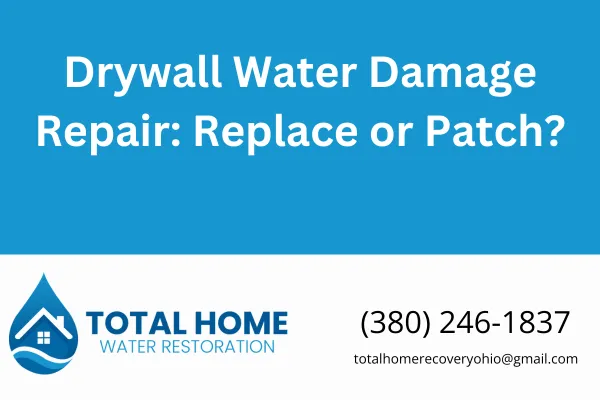
Drywall Water Damage Repair: Replace or Patch?
Drywall Water Damage Repair: Replace or Patch?
If you’ve had a burst pipe, roof leak, or water backup, odds are your drywall took a hit. Maybe it’s stained, sagging, soft, or even growing mold. Now you’re stuck wondering: should I patch it or rip it out and replace it?
At Total Home Water Restoration, we’ve seen it all. Here’s what you need to know to make the right call for your home—and avoid bigger problems later.
When You Can Get Away With a Patch
Sometimes, a small patch is all you need. Here's when patching makes sense:
The area is small—less than 6 inches across.
The drywall is fully dried out (within 24–48 hours of getting wet).
There’s no mold, no soft spots, no sagging.
The source of the water damage is fully fixed.
In these cases, we cut out the damaged section, dry everything, patch it with a matching piece, mud, sand, and repaint. Quick and clean.
When You Should Replace It
Here’s when we don’t mess around and recommend full drywall replacement:
The drywall is soft or crumbling.
You see discoloration or mold.
There’s a musty odor that won’t go away.
The water came from a dirty source (like a sewage backup or roof leak with insulation saturation).
You’ve got warping or bulging.
Wet drywall holds onto moisture and becomes a perfect breeding ground for mold. According to IICRC S500 and S520 guidelines, once drywall is contaminated—or even at risk—it should be removed and replaced to avoid structural and health issues.
What About the Insulation Behind the Wall?
Here’s something homeowners often miss: the insulation behind the drywall might be wet too. If you don’t remove the drywall and check, you’re taking a risk.
Wet insulation:
Loses its R-value (the thing that keeps your home energy efficient)
Can harbor mold
Takes forever to dry if trapped
We always inspect insulation as part of any drywall water damage repair.
Real Talk from Tyler
Last winter, we helped a homeowner in Hilliard with what looked like a small leak from a second-floor bathroom. Turned out, the drywall in the ceiling below was soaked, the insulation was saturated, and there was visible mold starting. It looked minor on the surface, but replacement was the only right move. We tore it out, dried the structure, treated the mold, and rebuilt it better than before.
Bottom line: what you see isn’t always what you’ve got.
What It’s Like Working With Us
When you call Total Home Water Restoration, here’s what we do:
Inspect the damage.
Use moisture meters and infrared cameras to find hidden water.
Follow IICRC-certified drying protocols.
Handle drywall removal, structural drying, insulation replacement, and rebuild.
Make it look like it never happened.
We’re based in Grove City and handle water damage in Columbus, Hilliard, Galloway, Westerville, and nearby towns.
FAQ: Drywall Water Damage Repair
Q: How do I know if mold is behind the drywall?
A: You may notice a musty smell, soft spots, or staining. We use moisture meters and thermal imaging to find hidden problems.
Q: Can I just paint over water stains?
A: Only if it’s fully dry and there’s no ongoing damage. Otherwise, you’re just hiding a growing issue.
Q: How fast do I need to act?
A: Within 24–48 hours of water exposure is best. After that, you risk mold growth and drywall breakdown.
Call Today—Don’t Wait for It to Get Worse
If your drywall’s been damaged, don’t guess. Get it looked at by a licensed, experienced restoration team that treats your home like their own.
📍 Total Home Water Restoration
4141 Hoover Rd, Grove City, OH 43123
📞 380-246-1837
We’re here to fix it right.
